Uni High Sophomores Build Infant Incubators Courtesy of POETS-RET-Developed Curriculum
June 11, 2019
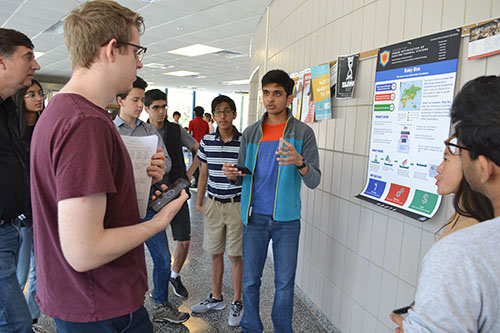
Joe Muskin and Christopher Aksland watch as a Uni High student gives his team's presentation.
During the spring semester, as a part of the POETS RET program’s ongoing curriculum development, University Laboratory High School (Uni High) students in science teacher David Bergandine’s chemistry classes tried out POETS’ Infant Incubator curriculum. Here's the scenario: students were to develop an infant incubator which could be used in the developing world in places where folks often can't use electricity. And because this was for a chemistry class, they were to use a chemical reaction to generate heat. Also as part of the curriculum, they were to create a poster and present at an end-of-the semester poster session, complete with judges and prizes.
A team of five judges made their way around the Loomis Lab atrium looking at the posters, listening to the students’ presentations, asking questions, then watching the video students had prepared. Each judge was assigned to three posters in the first session, three in the second. So not every judge saw every poster, but each poster was seen by three judges. The judges declared winners in the following categories: the best overall, the best poster, the best presentation, and the best video. As winners were announced, they had first dibs choosing from among the various prizes, including t-shirts, POETS mugs, laptop stickers, free sandwiches from Pot Belley’s, and laser pointers.

Joe Muskin shows off some of the loot available to the winning teams.
Joe Muskin, POETS’ Education Coordinator shared with the kids that one of the goals behind the project was to come up with a viable solution to a real-world problem. “Believe it or not, there was some kind of an ulterior motive behind some of this,” he claims. “This is a real problem. So maybe some of you will have a real solution to do it.”
He admits that another goal of the project was to developing a curriculum that could be used in other classrooms. “You, without knowing it, you were actually the Guinea pigs,” he told the students at the beginning of the poster session, “kind of giving us ideas of things that we want to put into the curriculum, such as supplies for the more general curriculum. You guys kind of had a more free reign because of your unique gifts...We really do appreciate this. Your work is not just for this judging; we're actually going to be looking at it to help drive this curriculum that we're developing.”
According to Bergandine, his high school students benefitted from the poster session in the same way that undergrads and graduate students do when presenting poster sessions in a professional manner.
“Our kids are simply gaining that same experience now. So they perform a research project. They have to also do literature research, write about it. They collect the data in the laboratory, perform their testing, and then have to support that with visual aids posters, video presentations, as well as talks. That's exactly the thing that undergrads and graduate students would do when they have a research experience.”
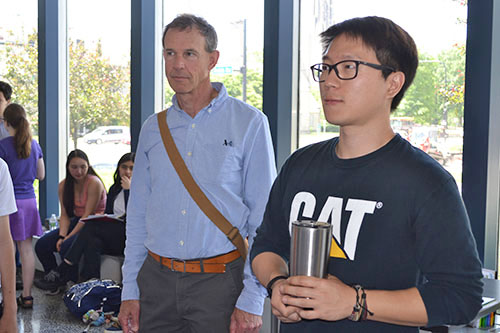
David Bergandine (center) and Andy Yoon (right) watch a team give their presentation.
Did his students know that what they were doing was research? “Well, they know that it's research in the sense that they are starting with a problem and attempting to find a solution that they can't simply look up somewhere. And so they have to design and test and redesign and retest. And that's what research is really all about. Does that mean that there is no portable incubator anywhere else in the world? No, but it's still an ongoing problem for probably over half of the children in the world that don't have access to incubators. And so one of their designs or one of their ideas could be connected to a future use.”
Bergandine believes that his students appreciated knowing that they might be helping to solve a real-world problem. “I think it's a great motivator when kids know that they have authentic problems to work on, and it's not just something that's been assigned to them to solve from a book…In this case, they came up with their own independent designs.” He also believes working on a real-world problem kept them engaged. “So they were taking their own initiative and worked on it consistently every day. Unlike a school situation where you might have some kids not as enthusiastic, these kids were enthusiastic every day, almost all the time doing one or other aspect of their project.”
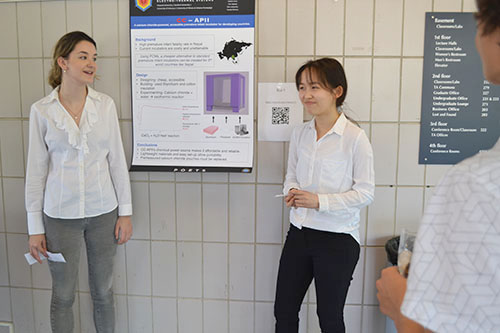
Two students present their incubator poster.
One challenge his students encountered was that an incubator needs to have a relatively constant temperature. So they had to come up with a system that could not only deliver the heat but also moderate it. “That was challenging for kids because they're were working with chemical systems, ordinary materials where you have problems like spillage or manufacturing materials that work, but not quite the way you want. You have to go back, start again, and create a new batch. So the amount of time that went into those kinds of things was definitely an obstacle, a challenge. But most of the kids also met the challenge.” Plus he reports that the groups actually had data to support that.
Bergandine believes another positive impact of the project was refuting the paradigm that science is always test tubes in a laboratory. He recalled that in some cases, they were using a sewing machine to sew fabric together, or using their kindergarten skills—cutting and pasting—literally designing their objects. Then they performed test that didn't take place in conventional laboratory glass, but within their device. "And so I think they recognize that science and engineering really goes outside of what you might think of as a laboratory and actually into someplace like a hospital room or a person's home that doesn't have access to an incubator. How could you actually provide that? And some of their devices might be part of the solution."
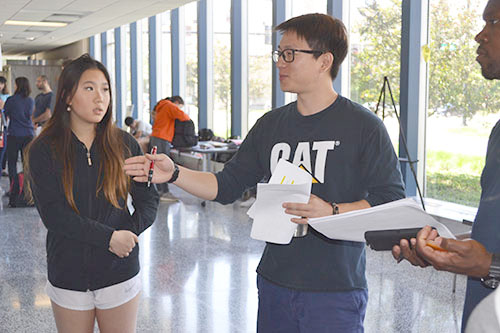
Electrical and Computer Engineering grad student Andy Yoon interacts with a team of students.
What was most important to the judges: the engineering design, teamwork, good problem solving, or the best presentation? One judge, Electrical and Computer Engineering grad student Andy Yoon, reports that “other than, of course, content,” he was mostly going to look for their ability to “show the things that they worked on over the semester and, mostly presentation skills, to see if they're showing that passion into their project and if they really believe that theirs is indeed better than others…Viability yes, but mostly passion. They gotta love their project.”
Another judge, Joe Bradley, Engineering IEFX faculty member, planned to reward problem solving as well as the teamwork. “Just being creative in the way that they approach problem solving—not thinking there was only one solution.” He also appreciated the variety—how different the projects looked. “So everyone had a different approach or what they thought their incubator should look like. And I liked that!” While he says they needed to get the chemistry right, he appreciated that they demonstrated a lot of their work by trying to get the best design device for them.
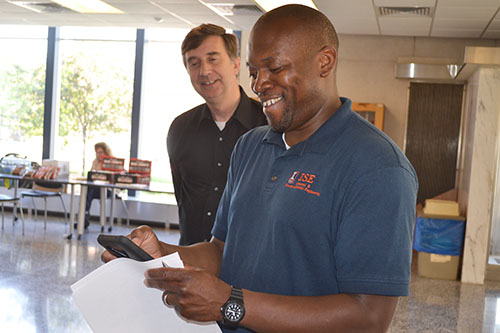
Joe Muskin and Joe Bradley (right), watch a team's video presentation.
Regarding the quality of the projects and the posters, another judge indicates: “These posters overall, just their presentations, are actually really good overall.” In fact, he says some were better than ones he’s seen at conferences. “Just the amount of preparation that the students put in, the amount of thought that they put into some of their things. I don't necessarily agree that all of them are practical solutions, but some of them are very impressive, especially for high school students. So overall, it's going to be hard to decide which ones are the best. It's going to be close.”
Another judge was Albert Patterson, a PHD candidate in ISE (Industrial Systems and Engineering). His advisor works with POETS and he was free and they asked him, “Hey, you want to come judge and get free lunch?” So he did.
Regarding what impact the project might've had on the Uni High students, he reports, “This project and the end poster thing, critical. Critical thinking to be able to follow a prompt up—a pretty vague prompt actually.” He indicates, “Some of the solutions are kind of what I'd expect to be kind of cookie cutter solutions from, say, engineering students, but that it's from high school students is really, really impressive...Some of the solutions that I've seen are very unique things. All these students are doing a really good job with this.”
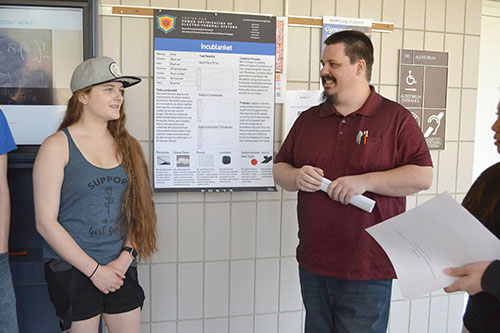
Albert Pattinson (right), a PHD candidate in ISE (Industrial Systems and Engineering), interacts with students presenting their research.
Patterson shares one of the benefits of having students do something more project based: no one person has all the answers. “Oh, they get a vague open-ended problem, and they have to really think about it, and they have to collaborate with the team, and all of them have to come together and be able to critically think as a team through a problem that's open ended. So that's the really important thing.
“Critical thinking is the most important thing,” he adds, “That's what we're trying to educate people to do, right?"
Another judge shares what he believed was the most impressive thing about the students: “I think they really demonstrated a lot of creativity, and to be sophomores, there was quite a bit of really good approach to the design. So they had a very well structured, very well organized, and did very well at communicating what they had done. So I will say that's probably what was a big takeaway from it.”
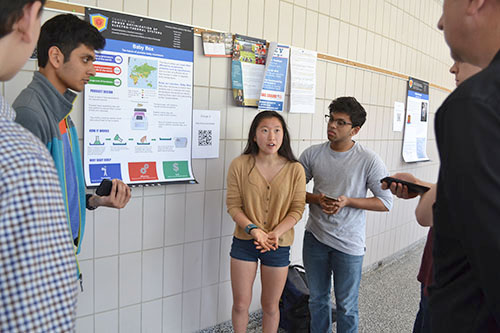
Uni High students present their poster.
Bradley shares what he believed was the most impressive thing about the students: “I think they really demonstrate a lot of creativity, and to be sophomores, there was quite a bit of really good approach to design. So they had a very well structured, very well organized project, and did very well at communicating what they had done. So I will say that's probably what was a big takeaway from it.”
He admits that the hardest thing about judging was that they all did a great job. “So it’s difficult when everyone has put a lot of effort and work behind it, and you can see that in the way that they discuss what they've done and can articulate about the reactions and how they went through a design process. So I think it's gonna be hard for us judges to come to consensus.”
Regarding the benefit of the project for the students, another judge, Patrick Birbarah, says: “I think the projects presented a great learning and creativity experience for the students. A span of different interesting designs were provided."
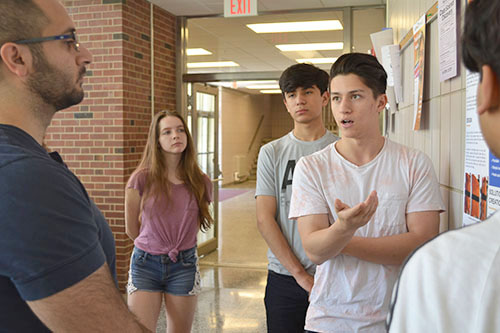
A Uni student discusses his team's research with judge Patrick Birbarah.
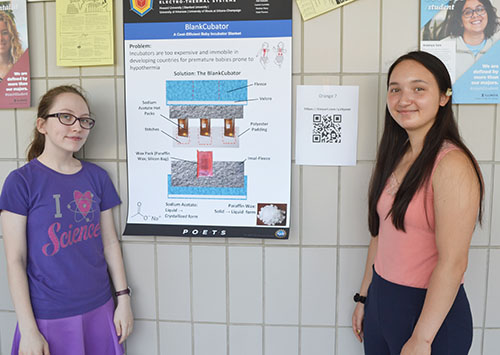
Uni High students Katie Powers and Lauren Mettlett by their poster.
Nicholas Phillips, a Uni High sophomore, shares what he thought of the project. “I thought it was a fun time,” he admits. “I learned a lot about reactions and stuff through this. and then also a lot of group work’s fun. And then the time crunch was kind of rough, but it came out well in the end.”
How did it make him feel knowing that his project was something that could make a difference in people's lives all over the world? “That's pretty great,” he acknowledges. “I think we made a good product and a little bit more time, it could've been something pretty great.”
Tom Simon Orille-Frost, also a sophomore, shares what he found to be the most challenging thing he encountered about doing this project. “I think it was finding a reaction,” he says. “We had a really tough time finding one that would produce enough heat that would actually heat the baby up, but one that also then wouldn't burn our baby. And then we also had to make sure we had one that didn't produce any noxious gases.”
He reports that it took him and his team a good week and a half until they finally settled on magnesium sulfate with waters, because they also wanted something that was cheap.
He reports that the project was much more fun than poring over a textbook. “Studying is so repetitive,” he admits, “and I get so tired of it, especially being at Uni. But being able to have a group project where I get to work with my friends and do something that could end up actually helping someone in the world was just amazing.”
While a textbook is “more about memorizing facts and formulas and stuff,” he adds, “This was more about thinking for ourselves and trying to work something out ourselves. I learned a lot during this.”
Katie Powers, another Uni High sophomore, says she found the project to be interesting because it made them think in a different way. “Because even though we've been learning this stuff in chemistry, we haven't really seen how to use it in real life. And we've gotten to do that in this project.”
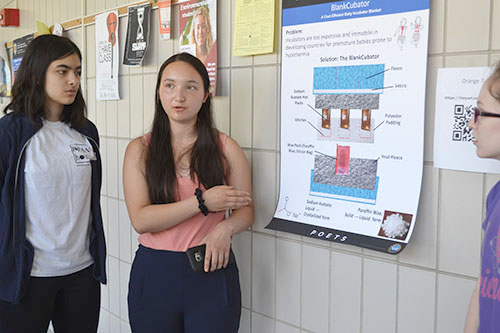
Lauren Mettlett presenting her team's poster.
She also found working on something that could really help a lot of people to be pretty exciting. “You're doing something new and it could actually be something useful. Like this is actually how you're using this stuff you're learning in high school, which sometimes it doesn't seem like that will ever happen.”
Regarding the difference between learning via a textbook and learning by experimentation, she indicates, “In a textbook you're told, ‘This is how it works!’ When you're actually creating something, you can see, ‘Oh, this is how it works!’ just by experimenting. And then you remember it better, and you really learn it on your own.”
So what was the most challenging thing about the project? She says just figuring out how the problem could best be solved and narrowing it down from the many different ways to do it. “Once we figured out, ‘This is what we want to do,’ it's a lot easier as you go from there. But the challenge was coming up with ideas and figuring out which one could be implemented."
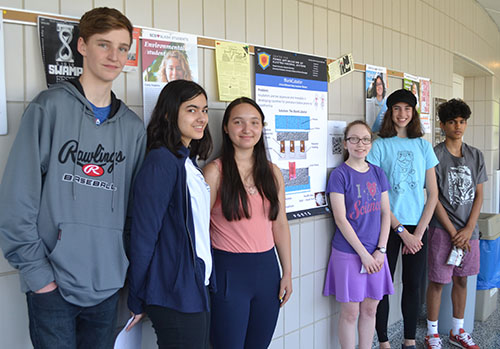
The BlankCubator team by their poster.
Sophomore Lauren Mettlett believes the project was more design oriented than experience-oriented compared to regular chemistry class. She explains that her group, instead of doing chemical reactions to produce heat, chose to do state changes, which they felt were a lot simpler and more easily renewable. In middle school, each trimester she had to create a device that worked according to certain parameters. “So I feel like those experiences really helped me here in knowing what I was doing…I had never really worked with chemistry, so I was able to apply some of the principles that I learned early this year to my design. And, it was a great experience.”
For her, the most rewarding thing was working with her group, which she calls really great. “I have a really great team and I really enjoyed working with them and I think we did a great job in the end. So I'm really proud of what we did.
In fact, she says she might even end up doing chemistry research. “It was definitely very interesting,” she says. One intriguing part for her was that they kind of had to guide themselves, which can be tough sometimes, but working together, it was easier to do. I am interested in medicine, maybe not necessarily a good research I noticed very difficult, but I've definitely enjoyed this experience. So if I had the opportunity, I would, yeah.”
Story and photographs by Elizabeth Innes, Communications Specialist, I-STEM Education Initiative.
More: 8-12 Outreach, POETS, University High, 2019
For additional articles about POETS, see:
- Dr. Howard Fourth Graders Learn Engineering, Problem-Solving, While Building Solar Cars
- POETS’ Education Program Introduces Students of All Ages to Interdisciplinary Research in Electro-Thermal Systems
- POETS Seeks to Change the Attitudes, Shape of Students in the STEM Pipeline
- POETS, New NSF Center at Illinois, Poised to Revolutionize Electro-Thermal Systems
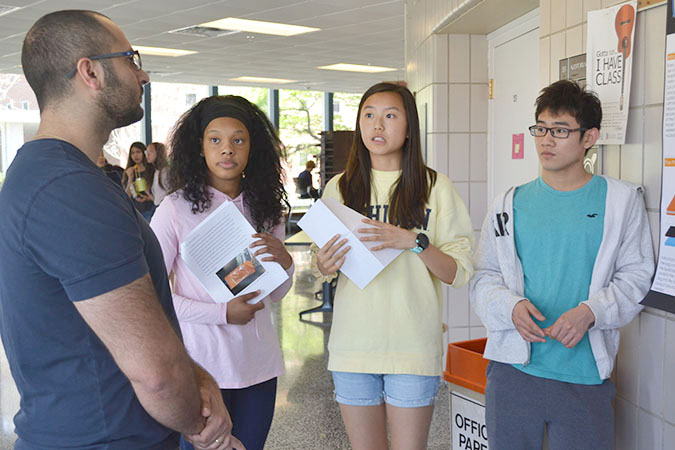 Uni High Students present their incubators to one of the judges, Patrick Birbarah (left).
Uni High Students present their incubators to one of the judges, Patrick Birbarah (left).












.jpg)
















